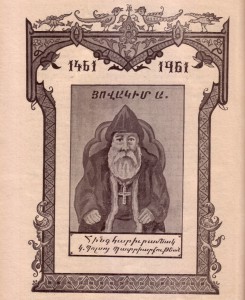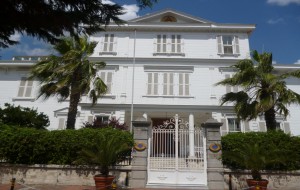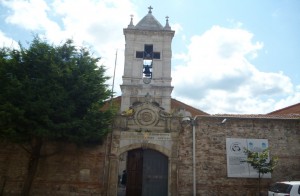The Foundation and Status of the Istanbul Armenian Patriarchate
Mehmet the Conqueror, after the conquest of Istanbul, asked the Greeks living in the city to choose a patriarch within their religious traditions and he approved Georgios Kurtesis Scholarius who was chosen as the new patriarch to be appointed with the title “Gennadios.” The sultan, who declared an edict about the administration of the patriarchate, stated that Gennadios had all the rights that the previous patriarch had, Orthodox people living within the Ottoman borders were under the responsibility of the patriarch henceforth, religious cases would continue to be tried in the Patriarchate Spiritual Assembly just as they were before, and that these right that they owned were under his support and guarantee (Shaw, 2004, p. 85).

Bursa Armenians Chief-episcopos Hovagim, brought to Istanbul from Bursa by Mehmet the Conqueror in 1461
The Conqueror created a similar structure for Armenians, as well, after the Greeks. When Istanbul was conquered, Armenians also had a religious center in Istanbul. However, it is not certain if this was in the form of a patriarchate like the Greeks or not. For this reason, the developments about the foundation and development of the Armenian Patriarchate were different from those of the Greek Patriarchate. Actually, Mehmet the Conqueror established the Armenian religious center in Istanbul as an episcoposship (religious authority of the city or the region of its location only) and this institution was raised to the status of patriarchate in later years. According to the narration often repeated and generally accepted regarding how and when the Istanbul Armenian Patriarchate was established, the establishment coming with the conquest of Istanbul took place as follows: “When Mehmet the Conqueror was in Bursa before the conquest of Istanbul, he showed an intimacy and love for the Armenian people and Hovagim who was the spiritual leader of them there. When the Conqueror was talking with Hovagim one day, Hovagim prayed that “May God make your kingdom higher than the other kingdoms” and the Conqueror responded a promise which was “If I achieve to conquer Istanbul, I will take you and Armenian leaders to Istanbul and I will make you the leader of them.” The Conqueror who came to Bursa a few years after the conquest of Istanbul in 1453 remembered his promise and he brought many Armenian families and Episcopos Hovagim from Bursa to Istanbul. In this same period, he brought Armenian groups from other regions to Istanbul and placed them in the capital. After the placement of these Armenians in different parts of the city (1461), the Conqueror, with an edict, declared Episcopos Hovagim as the leader of Armenians, the patriarch. Hovagim was given the authority of ruling over all Armenians in Anatolia and Rumelia. The patriarchate also maintained its existence after this date.” (Çarkçıyan, 2006, p. 21-25; Küçük, 2009, p. 152).
Although this narration about bringing Episcopos Hovagim to Istanbul and what happened before that is accurate, the fact that the establishment of patriarchate is a little different than this narration is put forward with various studies today (Bardakjian, 1982, p. 89-100; Dayan, 2011, p. 39-50). Mehmet the Conqueror revived the Armenian delegacy in Istanbul, which was deactivated in the last periods of Byzantine, by bringing Hovagim and his companies. He gave the responsibility of Armenians under his rule to this center in the capital and defined the administration of the Armenian nation just as he did with the Greek nation. The title “patriarch” given to the leader here took place in the periods of Yavuz Sultan Selim and Suleyman the Magnificent. The Ottoman Empire which took all Armenian religious centers in the world under his rule, started to officially use the name Istanbul Armenian Patriarchate after those dates.
Starting with Hovagim, who was brought to Istanbul from Bursa during the reign of Mehmet the Conqueror, the title given to Armenian leaders in Istanbul until the middle of 16th century was not “patriarch” but “marhasa.” The meaning of the title marhasa (or deputy) in the church literature was “the chief-episcopos of a city or region.” Chief-episcopos meant the clergy with the highest rank in a region.
Transition from a marhasalık (delegacy) to a patriarchate took place as:
The highest religious position of the Armenian nation is Eçmiyazin Cathogicos, which is situated in Eçmiyazin near Yerevan, the capital of today’s Armenia (Armenians call their highest religious leader “Cathogicos” which is in a way like “the Pope”). Although the oldest and highest cathogicos center is Eçmiyazin, there were cathogicoses established over time in “Ahtamar” near Van and “Sis” near Adana. Under these cathogicoses, there are patriarchates which are a lower religious center. These are the Jerusalem and Istanbul patriarchates. The religious center established the latest is the Istanbul patriarchate. The church structure from the highest to the lowest according to the church hierarchy is as follows:
- Açmiyazin Cathogicos
- Ahtamar Cathogicos
- Sis Cathogicos
- Jerusalem Cathogicos
- Istanbul Patriarchate
(Seyfeli, 2005, s. 37-49)
This hierarchy continued to exist until the last periods of the Ottoman Empire. Today, other religious centers, except for the Ahtamar and Sis Cathogicoses, continue their activities.
When Mehmet the Conqueror conquered Istanbul, other religious centers apart from Istanbul were outside of Ottoman rule. Therefore, it is apparent that other religious centers would not accept this institution even if the Conqueror called it directly the “patriarchate.” So, the fact that the titles of Hovakim and his successors were “marhasa” confirms this detection. Even today, some Armenian groups do not accept the Istanbul Armenian Patriarchate as an official religious center. The patriarchate, claimed to be a “de facto” institution (Braude, 1982, p. 82), is stated to be a “religious center created by the Ottoman Empire” and it is even said that this did not have any authority over Armenians (Kévorkian-Paboudjian, 2012, p. 11).
The progress of the process about the patriarchate after Mehmet the Conqueror took place as such: The fact that Yavuz Sultan Selim expanded the ruling area of the Ottoman Empire with the Çaldıran Victory, and then the Mercidabık and Ridaniye wars resulted in significant political changes for Armenians as well as for the Ottoman Empire. As a result of these successes of Selim, first Jerusalem and Sis were included in the Ottoman dominion, and then with the Iran expeditions (1534-1548) during the reign of Suleyman the Magnificent mainly Eçmiyazin and other important Armenian settlements were taken under Ottoman rule. Thus, all Armenian religious centers had come under Ottoman rule. Although it was thought in the beginning that the power of the authority in Istanbul would be restricted with the Eçmiyazin Cathogicos, which was superior to the Istanbul church in terms of religious authority, coming under the rule of the Ottoman Empire, the process developed exactly in the opposite direction. This situation made the power of the Istanbul religious center increase, let alone restricting it. As it was in the capital of the country, and the Ottoman Empire regarded the spiritual leadership in Istanbul as more superior to other Armenian religious centers. The increase of the power of the Armenian religious center in Istanbul rapidly continued after this date. Especially during the reign of Suleyman the Magnificent, this power was reinforced during the services of Marhasa Krikor (1526-1537) and Patriarch Asdvadzadur (1538-1543), and the title of “patriarch” given to the leader of this institution in Istanbul happened only at the end of this period (year 1543) (Bardakjian, 1982, p. 90).
The conclusion out of all these is that the duty of Hovagim, after coming to Istanbul from Bursa, was not patriarchate, but the spiritual leader of the Istanbul Armenians just as it was in the Byzantine times. Yet the most significant detail here is that the Conqueror himself appointed the religious leader of the Istanbul Armenians and that “Armenians, like Greeks, too, established a religious organization to be addressed by the state and this was supported by the Ottoman Empire.” (Emecen, 2008, p. 14). After these dates, Hovagim and later Armenians leaders, though they did not have the title of patriarch, were considered as the “Armenian nation leader” by the state within the Ottoman millet system – as it was the same with Greeks as well. The “Armenian nation leader,” who was responsible for the religious and civil works of the community under his leadership, administered the community on behalf of the Ottoman Empire and the Sultan. Also, Assyrians, Copts, and Habeshs were also assigned to the Armenian Patriarchate. There, groups were also subject to the Armenian Patriarchate for their religious/political issues.
After the completion of the establishment of the patriarchate, (until it was moved to Kumkapı Surp Asdvadzadzin Church, which is also used as the patriarchate center today) the Surp Kevork Church (Sulu Monastery) in Samatya was used as the patriarhate church, and the building opposite the church was used as the office of the patriarch and the center for the other work of the patriarchate. The Surp Kevork Church, which was an ancient Greek Church constructed on the Peribleptos Monastery from Byzantine time, was taken from the Greeks and given to the Armenians.
As well as the Armenian Patriarchate represented Armenian community under Ottoman rule as it is mentioned above, it also represented the Ottoman Government for the Armenian community. In order to carry out these double representative duties, the patriarchate had the right of punishing its community with various penalties (imprisonment or exile). However, these rights were valid for the attacks against its administrative authorities and the implementations were subject to the approval of the government. The government also supported this right of the patriarch, who had to get the permission of the government, especially for the penalty of exile, and reinforced his authority over the community. Also there was a military troop under the command of the patriarch. These soldiers called “repressor” and made up of janisarries, helped the patriarch in using his administrative authority. The Armenian community chose the patriarch according to their own traditions and the chosen person was approved in the position by the Sultan after giving a tax called “pişkeş” (Kenanoğlu, 2007, p. 154-155).
The only class which restricted the authority of the patriarch over the community and strengthened so much as to govern the patriarchate sometimes was the Armenian aristocrats called “amiras.” This class, which existed during the reign of the Conqueror as well and appeared especially after Suleyman the Magnificent, brought Armenian bankers and traders living in Van, Eğin and some other regions to Istanbul following the conquests of Revan and Nakhchivan in 1554, held the authority in the administration of the community, paralleling their economic powers. Amiras who paid the “pişkeş” tax which patriarchs and other episcoposes paid to the state were gaining authority over the clergy as a result of this situation. Armenian clergies were not an economically powerful class. Thanks to their wealth and intimacy with state authorities, this authority of amiras would increase even more and the administration of the patriarchate would directly be possessed by them (Barsoumian, 2013, p. 39-177).
This administrative structure within the Ottoman nation system would last until the Tanzimat period and the transformation of the Ottoman Empire in terms of administration would reflect on the non-Muslim administrations as well. Especially after the declaration of the Armenian Nation Regulations in 1863, the duties and authorities of the patriarchate would also become different (Güllü, 2013, p. 38-56).
Bibliography
Bardakjian, Kevork B. (1982), “The Rise of the Armenian Patriarchate of Constantinople”, Christians and Jews in the Ottoman Empire: The Functioning of a Plural Society, (Ed.: B. Braude – B. Lewis), Book: I – The Central Lands, New York – London, Holmes & Meier Publishers, Inc., pp.(?)
Barsoumian, Hagop L. (2013), İstanbul’un Ermeni Amiralar Sınıfı, (Translation: Solina Silahlı), Istanbul, Aras Yayıncılık.
Braude, Benjamin (1982), “Foundation Myths of the Millet System”, Christians and Jews in the Ottoman Empire: The Functioning of a Plural Society, (Ed.: B. Braude – B. Lewis), Book: I – The Central Lands, New York – London, Holmes & Meier Publishers, Inc., pp(?)
Çarkçıyan, Yervant Gomidas (2006), Türk Devleti Hizmetinde Ermeniler, Istanbul, Kesit Yayınları.
Dadyan, Saro (2011), Osmanlı’da Ermeni Aristokrasisi, Istanbul, Everest Yayınları.
Emecen, Feridun (2008), “Osmanlı Toplumunda Birlikte Yaşama Anlayışı ve Ermeniler”, Yapay Sorun “Ermeni Meselesi”, (Yayına Hazırlayan: Mahir Aydın), Istanbul, İstanbul Üniversitesi Avrasya Enstitüsü Yayınları., s. ?
Güllü, Ramazan Erhan (2013), Ermeni Sorununun Ortaya Çıkış ve Gelişim Sürecinde İstanbul Ermeni Patrikhanesi’nin Tutumu (1878-1923), Istanbul University Social Sciences Institute, Un-published Doctoral Dissertation, Istanbul.
Kenanoğlu, M. Macit (2007), Osmanlı Millet Sistemi – Mit ve Gerçek, Istanbul, Klasik Yayınları.
Kevorkian, Raymond H. – Paboudjian, Paul B. (2012), 1915 Öncesinde Osmanlı İmparatorluğu’nda Ermeniler, (translation from French: Mayda Saris), Istanbul, Aras Yayıncılık.
Küçük, Abdurrahman (2009), Ermeni Kilisesi ve Türkler, Ankara, Berikan Yayınevi.
Seyfeli, Canan (2005), İstanbul Ermeni Patrikliği, Ankara, Aziz Andaç Yayınları.
Shaw, Stanford J. (2004), Osmanlı İmparatorluğu ve Modern Türkiye, Book 1, Gaziler İmparatorluğu – Osmanlı İmparatorluğu’nun Yükselişi ve Çöküşü 1280-1808, (Translator: Mehmet Harmancı), Istanbul, é Yayınları.
Categories
- Experience of Living Together of Turks and Armenians
- Demographic Structure of Armenians in the Ottoman Lands
- Disturbances in Anatolia: Protests and Anarchy
- Armenians and the International System: Seeking a Solution
- Historiography in Turkish-Armenian Relations
- Dispatchment and Settlement: Discourses of Genocide
- Trials and International Law
- Armenians in Society and Bureaucracy
- Armenian Diaspora
- Church, Identity, and Social Structure


